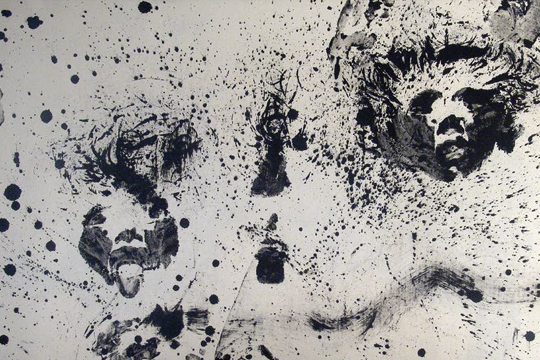WANG PENG: A CROWD OF ONE
| July 23, 2013 | Post In LEAP 21

Although “Wang Peng: A Crowd of One” is billed as a retrospective of the artist’s 30-year career, one has difficulty placing the exhibition inside an existing art historical framework. Many a typical retrospective would have the artist carefully select the works shown, exhibition approach, and the venue. The artist would pay close attention to the subtle shifts and emergence of each style, or take the occasion to present an evolution, say, of painting into sculpture. Although these kinds of exhibitions appear masterful and contemplative, the state of contemporary art always makes the viewer aware that both style and symbolism are equally nothing more than poor derivatives driven by market factors.
In contrast, Wang Peng’s exhibition begs for rumination. When there is such a proliferation of creative media, how does an artist maintain creativity? And what is this creativity? What kind of experience does it transmit and broadcast to the public? Taking these questions as a starting point, this multiplex exhibition doesn’t resemble something from the museum. Instead it has the feeling of an event occurring at a designated location, where after toiling away for years in his studio, the artist takes a few artworks out of storage for some fresh air in front of an audience.
This is not an exhibition of documents, then, nor does it locate Wang Peng’s art along a timeline. There is no hierarchy, even though Wang has been a part of the Chinese contemporary art scene since 1984, and has been working for 30 years. This also isn’t a retrospective, because it does not attempt to isolate individual periods or identify stylistic change. It does not depend on the artworks being originals, nor can its value be diminished by the minutiae of individual artworks. In fact, the value of this exhibition becomes apparent when all of the artworks are exhibited as a whole, which liberates Wang from stylistic history, the market, systems, and other regulated conditions. Together, the works can become undefined, without discipline, and free from these shackles.
Worth applause is how Wang Peng has preserved, from the very beginning of his career until now, his uniquely direct sensibility toward art objects. In his earliest performance, 84’s Performance, Wang covered his naked body with ink and then used it to print on xuan paper. In an interview with Britta Erickson, Wang revealed that his younger self created the work out of a need to vent a causeless anger, seeking release from oppression and dissatisfaction. There are similarities to Song Yongping’s remembrance of his 1986 performance at the Modern Art Exhibition in Taiyuan, Shanxi, the first such presentation of performance art in the 1980s. Song Yongping and Song Yonghong covered their bodies with paint, sat amongst a pile of strangely shaped clay pots, and moved as if possessed by spirits. There was a similar lack of purpose, behaving purely out of a biological or spiritual joy.
This kind of behavior could be described as a reflection of self-experience. It perfectly illustrates the indispensability of Chinese contemporary artists like Wang. It is also what is meant by having an understanding of bodily experience. Unlike the young artists of today, who have chosen a theoretical approach to making art that is refined to the point of being precious, Wang and his contemporaries can be described to have taken “a straight shot into the promised land.”
Whether it is his performance from 1984; his installation Wall (1993), where he used bricks to seal off the door to a gallery exhibiting his works; or the painting Hall (1996), which explored politics and concepts, Wang’s creative impulses all come from rough and direct experience. The ideas behind the works—rebuking the gallery system, ideological critique, or commentary on institutions— don’t seem as important. After all these years, what remains most moving in Wang’s art is still the roughness that shines outward. Wang is without doubt an old avant-gardist, yet he has luckily escaped being co-opted by commercialism and the consumerist system. Compared to the bells and whistles of conceptual art, his works are more like the mythical triple bevel broadax: whether slashing, slicing, or stabbing, each move lands an effective blow.

